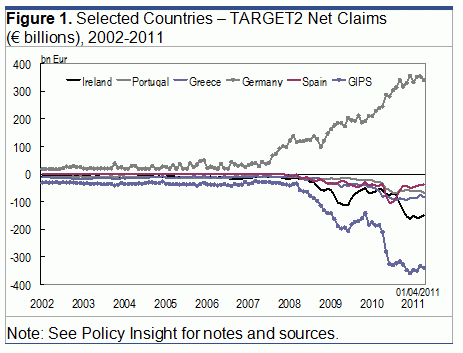Since the euro’s creation, net claims and liabilities of individual central banks with respect to TARGET2 were small. Recently however, the liabilities of several central banks along Europe’s periphery have boomed. Simultaneously, the Bundesbank’s claims on TARGET2 rose – basically in line with the periphery’s liabilities (see Figure 1).1
- What has caused this rise?
- And what are the implications for Europe?
The debate rages.2
This column introduces a new CEPR Policy Insight (Buiter et al 2011) that outlines the facts and their interpretation. We leave aside the who-said-what polemics.
How do TARGET2 imbalances arise?
Our CEPR Policy Insight (Buiter et al 2011), presents a stylised model of balance sheets in the Eurozone. It assumes two countries, Germany and Ireland – each with just three sectors – the national central bank, the banking sector, and the rest of the economy. We present two examples of types of transactions that can give rise to large changes in TARGET2 balances.
Example 1: An Irish farmer borrows from an Irish bank to buy a German tractor
Consider the following example: An Irish farmer borrows X euros from an Irish bank to purchase a German tractor.As a result of this transaction, the Irish capital stock increases and loan balance of the Irish economy with respect to Irish banks increases. Now assume (note that this is an assumption, if not an implausible one), that instead of reducing its assets or borrowing from other sources, the Irish bank increases its borrowing from the Central Bank of Ireland. The Central Bank of Ireland in turn increases its (gross and net) debt to TARGET2. In our model, as there were no other transactions in the current account of Ireland, its current-account deficit has increased. Such an example could in principle illustrate how an increase in the net TARGET2 liabilities of the Central Bank of Ireland is created or driven by an Irish current-account deficit.
Example 2: A German farmer moves deposits from an Irish bank to a German bank
Now consider a second example. Imagine a German farmer with a deposit in an Irish bank. Perhaps out of concern for the solvency of the Irish bank, the farmer decides to withdraw these deposits and instead deposits them within a German bank. Deposits held in the Irish bank by the rest of the German economy would fall. Assume again that instead of reducing its assets or borrowing from other sources, the Irish bank increases its borrowing from the Central Bank of Ireland to make up for the lost deposits and that the Central Bank of Ireland in turn increases its (gross and net) debt to TARGET2.
Spot the difference
The implications for the TARGET2 net balances of the Central Bank of Ireland or the Bundesbank are identical in the two examples. But the narrative is very different. The second example does not imply a current-account deficit or trade deficit of Ireland vis-à-vis Germany. Instead, the driver is what could be termed “deposit flight” – a movement of financial balances from Ireland to Germany which is, at least directly, unrelated to the demand for goods – it is a financial portfolio rebalancing that does not require any change in the national saving-investment balance.
Circumstantial evidence
The above discussion is not just theoretical. Figures 2 through 5 compare TARGET2 imbalances of national central banks and cumulative current-account balances for Germany and Ireland (see our report for more examples). While not ideal, these data are suggestive. The charts for Ireland (Figures 4 and 5) are particularly telling.
- The overwhelming majority of increases in Irish net TARGET2 liabilities were between 2008 and 2010; and
- In all three years increases in Central Bank of Ireland TARGET2 liabilities were multiples of the Irish current-account deficit;
If TARGET2 liabilities were financing the Irish current-account deficit with the rest of the world at all, they also financed an even larger net capital outflow from Ireland.
- We are careful to point out that this evidence is insufficient to allow us to conclude that current-account imbalances did not contribute to the increases in net TARGET2 imbalances.
At best, the presence or absence of close correlations is suggestive.3
Do increases in Central Bank of Ireland net TARGET2 liabilities reduce ECB/Bundesbank credit for German banks?
What do these imbalances mean for other Eurozone economies? For simplicity’s sake, assume again that an Irish farmer borrows X euros from an Irish bank to purchase a German tractor with the result that the Central Bank of Ireland ends up with an increases in its (gross and net) debt to TARGET2 (the implications from the other examples are equivalent).
The balance sheets of the Irish banks, the rest of Ireland, and its central bank all increase.
- As the central bank has borrowed from TARGET2, the credit to Irish banks also increases;
- The Irish monetary base is unchanged.
If the tractor was second-hand, the German capital stock falls while deposits with German banks from the rest of the German economy increase.4 At this stage, German banks face a choice.
- The first option is to take the increased deposits from the German economy and deposit them with the Bundesbank.
In that case, the German monetary base and the balance sheet of the Bundesbank would rise, and as a result also the total monetary base in the Eurozone would also rise.
- The second option for German banks is to deposit the extra funds with the Bundesbank, ie to reduce their loans from the Bundesbank.
Here German and Eurozone monetary bases are unchanged. The sizes of the balance sheets of German banks, the Bundesbank, and the rest of Germany would also remain unchanged. But in this scenario, Bundesbank credit to German banks would fall.
In our model, however, there is no reason to suspect that the second option is any more or any less likely to be taken by German banks than the first option – it would depend, among other things, on general funding conditions for banks, alternative investment opportunities, and the terms and conditions of central bank and private funding. Even if Bundesbank credit to German banks were to fall, we must be clear that it would be the result of a choice made by German banks. Whether the TARGET2 balance-increasing Irish transactions have “crowded out” CB credit to German banks is then a matter of semantics.
We argue that it is more likely that German banks chose to demand less Bundesbank credit. This is due to a combination of factors including the expiry of the 12-month long-term refinancing operation (LTRO) in July 2010, which would have made such credit a lot less attractive to banks.5
Do Bundesbank TARGET2 net claims reflect Bundesbank exposure to financial losses?
The Bundesbank’s exposure to possible ECB losses is given by the total exposure of the Eurosystem times Bundesbank’s share of ECB capital (see Table 1); all Eurozone central banks are similarly exposed. The exposure is limited to the size of the Eurosystem balance sheet – some €1.9 trillion on 27 May 2011. Of course, that exposure is balanced by the ECB’s capital.6
In short, the Bundesbank is an ECB shareholder. It participates in profits or losses made by the entire Eurosystem. The key point is that its exposure to losses bears no relationship to the net credit position of the Bundesbank vis-à-vis TARGET2. It bears only a moderate connection to the size of its own balance sheet. TARGET2 balances are remunerated at the refi rate, but as any resulting profits are shared within the Eurosystem, it is irrelevant whether the Bundesbank has positive TARGET2 net claims or negative ones. The one important qualification is that Emergency Liquidity Assistance (ELA) facilities are excluded (see our Policy Insight for details).
|
Table 1: ECB capital shares
|
|
|
Central bank
|
Capital key (%)
|
Adjusted capital key (%)
|
Paid-up capital (€)
|
|
|
Belgium
|
2.43
|
3.47
|
180,157,051.35
|
|
|
Germany
|
18.94
|
27.06
|
1,406,533,694.10
|
|
|
Estonia
|
0.18
|
0.26
|
13,294,901.14
|
|
|
Ireland
|
1.11
|
1.59
|
82,495,232.91
|
|
|
Greece
|
1.96
|
2.81
|
145,939,392.39
|
|
|
Spain
|
8.30
|
11.87
|
616,764,575.51
|
|
|
France
|
14.22
|
20.32
|
1,056,253,899.48
|
|
|
Italy
|
12.50
|
17.86
|
928,162,354.81
|
|
|
Cyprus
|
0.14
|
0.20
|
10,167,999.81
|
|
|
Luxembourg
|
0.17
|
0.25
|
12,975,526.42
|
|
|
Malta
|
0.06
|
0.09
|
4,694,065.65
|
|
|
Netherlands
|
3.99
|
5.70
|
296,216,339.12
|
|
|
Austria
|
1.94
|
2.78
|
144,216,254.37
|
|
|
Portugal
|
1.75
|
2.50
|
130,007,792.98
|
|
|
Slovenia
|
0.33
|
0.47
|
24,421,025.10
|
|
|
Slovakia
|
0.69
|
0.99
|
51,501,030.43
|
|
|
Finland
|
1.25
|
1.79
|
93,131,153.81
|
|
|
Total
|
69.97
|
100.00
|
5,196,932,289.36
|
|
|
Note: See Policy Insight for notes and sources.
|
Conclusions
The fates of sovereign and the banking systems in many Eurozone member countries, and in the Eurozone as a whole, are strongly intertwined, as first the financial crisis and soon after the Eurozone sovereign debt crisis has shown. Despite – or due to – the abundance of problems within the Eurozone, it is important to be careful in presenting and interpreting the facts in an objective way. In that respect, it is important to highlight that TARGET2 imbalances:
- Cannot be automatically linked to current-account deficits in those countries;
- Do not automatically reduce central bank credit to commercial banks in other member states (and any reduction of central bank credit should not be interpreted negatively, as implying reduced funding for banks and their customers); and
- Should not be interpreted as a measure of the risk exposures of the national central banks of TARGET2 creditor countries.
This does not mean that the increase in TARGET2 imbalances cannot be suggestive of serious problems.
- These imbalances may be – and currently likely are – a symptom of the difficulty of banking systems in a number of Eurozone periphery countries have in funding themselves in the markets without public support.
They should therefore primarily be understood as a call to action for policymakers to put the banking systems in the Eurozone periphery and core on a sound footing – a goal that continues to elude them even after almost four years since the onset of the financial crisis.
References
Alea (2011), “Professor Sinn and the interdistrict settlement account [wonkish]”, aleablog.com.
Bindseil, U and PJ König (2011), “The economics of TARGET2 balances”, SFB 649 Discussion Paper 2011-035.
Buiter, WH, E Rahbari, and J Michels (2011) “The implications of intra-Eurozone imbalances in credit flows”, CEPR Policy Insight No. 57
Buiter, WH, E Rahbari, and J Michels (2011a), “TARGETing the wrong villain: TARGET2 and intra-Eurosystem imbalances in credit flows”, Citi Global Economics View, 9 June.
Buiter, WH, E Rahbari, and J Michels (2011b), “TARGETing the wrong villain: a reply”, Citi Global Economics View, 5 July.
Federal Reserve System (2010), “Federal Reserve Banks Combined Financial Statements”, Annual Report 2009.
Garber, PM (1989), “Notes on the Role of Target in a Stage III Crisis”, NBER Working Paper 6619, June 1989.
Garber, PM (2010), “The Mechanics of Intra Euro Capital Flight”, Deutsche Bank, Economics Special Report, 10 December.
Sinn, H W (2011a), “Tickende Zeitbombe”, Süddeutsche Zeitung, No. 77, 2 April.
Sinn, H W (2011b), “Neue Abgründe”, Wirtschaftswoche, No. 8, 21 February.
Sinn, H W (2011c), “The ECB’s Secret Bailout Strategy”, Project Syndicate, April.
Sinn, H W (2011d), “Deep Chasms”, ifo Viewpoint No. 122, 29 March.
Sinn, H-W (2011e), “The ECB’s stealth bailout”, VoxEU.org, 1 June.
Sinn, H-W (2011f), “Germany’s capital exports under the euro”, VoxEU.org, 2 August.
Sinn, H-W and T Wollmershäuser(2011), “Target Loans, Current Account Balances and the ECB’s Rescue Facility”, CESIfo Working Paper No. 3500
Storbeck, O (2011a), “Traktoren, Targetsalden, Trugschlüsse – HWS hat sichverrannt”, Handelsblatt Blog, 3 June.
Storbeck, O (2011b), “The stealth bailout that doesn’t exist: debunking Hans-Werner Sinn”, olafstorbeck.com, 6 June.
Whelan, K (2011), “Professor Sinn Misses the Target”, IIEA Blog.
Wittaker, J (2011), “Intra-eurosystem debts”, Lancaster University Management School Working Paper.
Wolf, M (2011), “Intolerable choices for the eurozone”, Financial Times, 31 May.
1 TARGET2 net claims and liabilities are not reported explicitly or even in a consistent way by NCBs. Figure 1 depicts proxies for these balances, following Whitaker (2011).
2 These contributions include (but are not limited to) Garber (1989 and 2010) and more recently Whitaker (2011), Sinn (2011a,b,c,d,e,f), Sinn and Wollmershaeuser (2011), Wolf (2011), Whelan (2011), Buiter et al. (2011a,b), Bindseil and Koenig (2011) and Storbeck (2011a,b).
3 Just as correlation of X and Y does not imply causation from X to Y or from Y to X, the absence of correlation between X and Y cannot be taken to imply conclusively an absence of a causal relationship between X and Y, but certainly does not constitute evidence in favour of such a causal relationship, either. We provide more supportive evidence in our report.
4 If the tractor was new, that is, part of the current period’s value added in Germany, the accounting treatment would not involve a decline in the capital stock of Germany, but no essential conclusion would be different.
5 Compared to market funding rates, the interest rate for the 12M LTRO were very attractive for (even healthy) Eurozone banks.
6 Total capital and reserves for the Eurosystem are just over €81 bn. There is also, however, just under €306bn in the Revaluation Accounts, and this too should be loss-absorbing. In addition to the on-balance sheet exposure there are off-balance sheet exposures, such as swap lines with other central banks or lines of credit.







